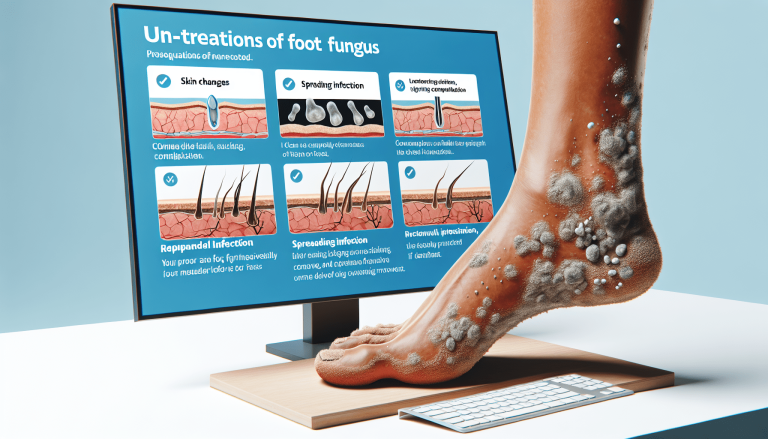What Is The Most Successful Treatment For Toenail Fungus?
Welcome to an insightful guide on effectively handling toenail fungus! In “What Is The Most Successful Treatment For Toenail Fungus?”, you’ll discover the most effective methods to banish this pesky problem for good. Through a combination of expert advice, scientific insights, and practical tips, you’ll learn about various treatment options, from over-the-counter remedies to prescription medications and even natural solutions. By the end of this article, you’ll be equipped with the knowledge to make an informed decision on the best treatment for your situation, ensuring healthy and happy feet! Have you ever looked down at your toenails and noticed something wasn’t quite right, like discoloration, thickness, or an odd texture? You might be dealing with toenail fungus, a common condition that can lead to embarrassment and discomfort if left untreated. So, what is the most successful treatment for toenail fungus? Let’s delve into the options available and find out the best approach to tackle this pesky problem.

What Is Toenail Fungus?
Toenail fungus, called onychomycosis in medical terms, is a fungal infection that affects your nails, primarily those on your toes. It’s more common than you might think and can occur due to a variety of reasons.
Causes of Toenail Fungus
Toenail fungus typically develops due to:
- Moist environments: Wearing sweaty socks and tight shoes contributes to the growth of fungi.
- Injury: Injuries that damage the nail or the skin around it make it easier for the fungus to infiltrate.
- Pre-existing conditions: Diabetes, compromised immune systems, and poor circulation can also make you more susceptible.
Symptoms of Toenail Fungus
Noticing yellow, brown, or white discoloration on your toe? Perhaps your nail is thickening or flaking. These are common signs of toenail fungus. Other symptoms include foul odor, brittleness, and even separation of the nail from the nail bed in more severe cases.
How Is Toenail Fungus Diagnosed?
If you suspect you have toenail fungus, consulting a healthcare provider is a critical step. A physician can typically diagnose the condition through a physical exam and sometimes a lab test, like a nail culture, to identify the specific type of fungus causing the issue. This diagnosis can help in choosing the most effective treatment plan.
Available Treatment Methods
There are various ways to treat toenail fungus, from medical treatments to over-the-counter solutions, and even home remedies. Let’s break these down:
Prescription Medication
Oral Antifungal Drugs
Oral antifungal medications like Terbinafine (Lamisil) and Itraconazole (Sporanox) are often considered highly effective, particularly for severe cases.
| Medication | Dosage | Duration | Success Rate |
|---|---|---|---|
| Terbinafine | 250 mg daily | 6-12 weeks | 70-80% approximately |
| Itraconazole | 200 mg twice daily | 1 week per month for 3-4 months | 60-70% approximately |
Pros:
- High success rates
- Targets the fungus from the inside out
Cons:
- Possible side effects, including liver damage and skin rashes
- Requires regular blood tests to monitor liver function
Topical Treatments
Topical antifungal prescriptions like Ciclopirox (Penlac) and Efinaconazole (Jublia) are also available. These are applied directly to the nail.
| Medication | Application Method | Duration | Success Rate |
|---|---|---|---|
| Ciclopirox | Apply daily; remove weekly | Up to 1 year | 30-40% approximately |
| Efinaconazole | Apply daily | 48 weeks | 50% approximately |
Pros:
- Fewer systemic side effects than oral medications
Cons:
- Less effective than oral treatments
- Long treatment duration
Over-the-Counter (OTC) Solutions
Antifungal Creams and Ointments
These include products containing clotrimazole and miconazole. They are easily accessible and can be a good starting point for mild cases or as complementary treatments.
Pros:
- Easily accessible
- Low cost
Cons:
- Generally less effective for severe cases
Home Remedies
There are several home remedies touted to treat toenail fungus. Popular examples include tea tree oil, Vicks VapoRub, and even vinegar soaks. While these methods can offer some relief, they are generally less effective than medical treatments.
| Home Remedy | Application Method | Evidence |
|---|---|---|
| Tea Tree Oil | Apply 1-2 drops daily | Limited scientific support |
| Vicks VapoRub | Apply thin layer daily | Limited scientific support |
| Vinegar Soaks | Soak feet in vinegar and water daily | Anecdotal evidence |
Pros:
- Natural options with fewer side effects
- Cost-effective
Cons:
- Limited scientific evidence
- Generally slower to show results
Surgical Options
In severe or resistant cases, surgical removal of the toenail might be recommended.
Pros:
- Removes infected nail, allowing a fresh one to grow
Cons:
- Invasive procedure with associated risks
- Requires recovery time
Preventing Toenail Fungus
Prevention is always better than cure. Here are some tips to help you avoid contracting toenail fungus in the future:
Foot Hygiene
- Keep feet dry: Change socks regularly and use moisture-wicking materials.
- Trim nails properly: Cut nails straight across and keep them short.
- Disinfect shoes: Regularly disinfect shoes and don’t share footwear.
Enhance Immune System
A healthy immune system can make you less susceptible to fungal infections. Eating a balanced diet, exercising regularly, and managing stress are key steps in boosting your immunity.
Wearing Proper Footwear
- Avoid tight shoes: They trap moisture and crowd your toes.
- Protect your feet in public places: Wear sandals in communal showers, locker rooms, and around swimming pools.
What to Do if You Suspect Toenail Fungus
If you notice any symptoms of toenail fungus, it’s advisable to consult with a healthcare provider for an accurate diagnosis and tailored treatment plan. Starting treatment early can prevent the fungus from spreading and causing more severe problems.
Monitoring Progress
Once you start treatment, keeping track of your progress is important. Regular check-ups with your physician will help to ensure that the treatment is effective and making the necessary adjustments if it isn’t.
Conclusion: The Most Successful Treatment for Toenail Fungus
So, what is the most successful treatment for toenail fungus? It ultimately depends on the severity of your infection, your overall health, and your personal preferences. Oral antifungal medications typically offer the highest success rates, but they come with potential side effects. Topical treatments can be effective for milder cases, especially if you prefer a treatment with fewer systemic risks. Over-the-counter options and home remedies can be good adjuncts but are often less effective as standalone treatments.
If you’re dealing with toenail fungus, the best approach is to consult with a healthcare provider who can guide you through the most effective treatment options suited to your specific needs. Taking proactive steps in practicing good foot hygiene and lifestyle adjustments are also key in both treating and preventing this common condition. Stay informed, be patient, and you’ll be on the path to healthier, fungus-free toenails in no time!
Additional Resources

Have you been using this popular fungus treatment in the last 6 months?
You need to stop immediately!
Because Scientists at the Infectious Disease Society of America just made a shocking discovery… After running hundreds of tests on people with foot fungus… They discovered that the infection is caused by this very treatment…
That 85% of people suffering from fungus use it at least once!
The amazing part is, after removing it from their routines, patients cleared nail fungus for good… Regrowing their nails and rejuvenating their skin… Without using any toxic creams or pills in the process.
Visit the page below to find out all about it:





